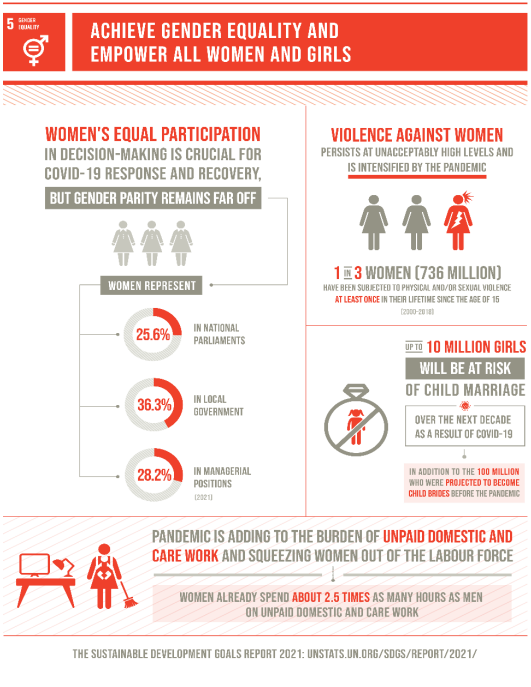
Emotionally Intelligent Living: Navigating the Heart and Mind
Emotionally Intelligent Living: Navigating the Heart and Mind Emotions are a precious tool to orient your decision-making process. Usually when we hear the word ‘intelligence’,
According to the UN, on average a woman spends 3 times as many hours in unpaid domestic and care work as men. Women occupy less than one-third of senior and middle management positions in a majority of the countries.

Source: https://unstats.un.org/sdgs/report/2021/
International Labor organization says that the global workforce participation rate is for women is 49% and that for men is 75%. It has been found that women have a harder time finding a job than men and even if they find one there are multiple barriers in the workplace like unequal pay, lack of recognition, and stigma attached to taking maternity leaves. Not to forget the harassment at the workplace.

Source: ILO
Talking about gender equality is especially important during the pandemic. McKinsey says that women make about 39 percent of global employment but account for 54 percent of global job losses during the pandemic. Pandemic has no doubt impacted women disproportionately. The gender gap has widened, and the progress made over the decades is being undone.
Before discussing how to bridge the gender gap at workplaces we need to know why gender equality is important for economic recovery and growth.
According to a McKinsey report:
• Considering a scenario in which no actions are taken to fill the gender gap our economy could be $1 trillion lower in 2030 than it would have been if women’s unemployment followed the pre-Covid trends. This is just an optimistic calculation. Things would be exacerbated if we factor in attitudinal bias, slow recovery, and reduced spending habits.
• On the flip side if actions are taken now to bridge the gap the value-added would be approximately $13 trillion to the global GDP in 2030.
Now, that we have the base built on how women are impacted and why gender equality is important – we will discuss what are the 5 most effective ways of doing so at your workplace.

Photo by Markus Spiske on Unsplash
“Leave it. It will be tough for you.”
“This is a man’s job. Leave it on me.”
“Don’t act like a girl.”
These daily – seemingly harmless statements are common remarks made at the workplace. Knowingly or unknowingly, they create a bias that women are not capable of taking up big responsibility. We need to keep a strict check on such remarks and castigate people who promote such stereotypes.

Photo by LinkedIn Sales Solutions on Unsplash
Women leaders although few have left a remarkable legacy for the world to see. From Cleopatra to prime minister of New Zealand – Jacinda Arden. Interestingly human species is one of few species which have a patriarchal structure. The majority of the world’s species are matriarchal.
At the workplace, we need to reevaluate how the minority gender at the workplace is seen. Women have the capability, but they need to be given a platform to showcase their abilities.
The competition should be fair and square.

Photo by Victoria Heath on Unsplash
Creating a work-life balance is tough especially for working mothers. They are vulnerable to the societal stigma around working women. A man is only required to work. The society holds him under no obligation to fulfill his duties towards his children or home. The same is not for a woman. She is under constant pressure to perform not only at a professional level but also towards her family.
Creating a structure that considers these differences will be a huge morale booster for working women. Promoting workforce participation.

Photo by Sharon McCutcheon on Unsplash
If the work done is equal shouldn’t the pay be equal? This seems straightforward but is rarely followed. Women on average earn 19% less than their male counterparts.
Equity theory says that output (rewards) by Input (work done) should be equal for everyone to foster employee satisfaction. Any inequity would lead to dissatisfied employees and loss of productivity.
As an organization, we should be responsible for the fair distribution of wages. By doing this we’ll promote a fair corporate culture and encourage productivity among the employees.

Photo by Priscilla Du Preez on Unsplash
Punishing people who discriminate against people based on gender or preference. Some people feel entitled to make fun of or harass someone based on gender or inclination. Taking strict action against them is imperative for the organization to
prosper.
Actions that can be taken against them are:
• Salary or incentive cut
• Reporting them to the concerned authorities
• Termination
This pandemic has pushed back the gender equality efforts by almost a decade. We as human beings have a moral obligation to care for those who have been neglected. Gender equality cannot be bridged in a year or two, but it’s achievable. We need to look beyond gender – at the bigger picture of prosperity. For our benefit and the benefit of our society, we need to come together to fight against such unjust practices.

Emotionally Intelligent Living: Navigating the Heart and Mind Emotions are a precious tool to orient your decision-making process. Usually when we hear the word ‘intelligence’,

Navigating the Transition from Campus to Corporate: A Guide to Developing Competency. The transition from campus to corporate requires more than just academic knowledge; it

Unveiling Leadership Mastery: Distinguishing the Art of Management from Genuine Leadership Introduction: In the ever-evolving landscape of business, the essence of true leadership stands as
Copyright © 2023. All Rights Reserved with CoEmerge. Designed by JustGlobal Technology